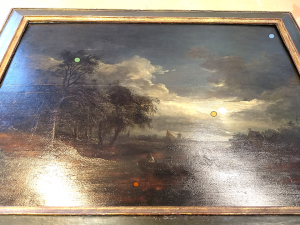A pigment is the substance that provides color to paint. Depending on when they lived and worked, a given range of pigments was available for artists’ use. Identifying a specific pigment can therefore help to date an artwork. To determine which blue was used in River Landscape by Moonlight, a painting in the Picker’s collection long believed to be by the Dutch painter Aert van der Neer (ca. 1603–1677), two miniscule paint samples were taken from the blue sky along the upper edge of the panel.
The samples were embedded in a clear substance called a thermoplastic, which becomes liquid when heated, but turns solid under room temperatures. One embedded sample was then ground down to create a cross-section, which shows that the blue was applied on a thin white ground. The other sample was chemically treated to isolate the blue pigment before being embedded and examined under a microscope. The shape, size, and refractive qualities of the pigment particles were studied, before testing their response to nitric acid. Many blue pigments that are known to look and behave differently could be excluded as candidates during this process.
Finally, these results were compared with those from X-ray fluorescence (XRF) of the painting’s materials. In XRF analysis, elements are identified based on the different levels of radiation they reflect back when exposed to x-rays. Because XRF revealed the presence of iron (Fe), the blue pigment in this painting could be confirmed as Prussian blue: Fe4[Fe(CN)6]3. Accidentally invented by a paint producer in Berlin ca. 1706, this synthetic pigment became widely available after 1730. We therefore know with certainty now that River Landscape by Moonlight could not have been done by a seventeenth-century artist like Van der Neer.
Forgery or misattribution?
Rejecting the attribution to Aert van der Neer presents two possibilities: first, that the work was deliberately forged to look like a genuine Van der Neer, or secondly, that it belongs to a legitimate, but as of yet unidentified artist active after 1730. Van der Neer’s works were commonly forged in the nineteenth century, as their romantic qualities were in high demand. One notable detail in the work could point to the involvement of a forger: an artist’s monogram in the lower right of the composition has been interpreted as Van der Neer’s signature in the past. Mostly illegible today, it could have been added to deliberately mimic Van der Neer’s well-known initials “AVDN.” However, this ambiguous signature could just as easily have belonged to an artist from a later period, whose name was eventually mistaken for that of Van der Neer. Works made after 1730 with a similar composition, style, and subject are currently being researched in an ongoing attempt to identify an artist whose body of work could include River Landscape by Moonlight. While this work remains unattributed at present, it is the museum’s responsibility to continue our assessment of its status and to educate audiences about our process of inquiry and its results.
The implications of the results from pigment analysis for the interpretation of River Landscape by Moonlight and its possible authorship were researched by curatorial intern Elise Kennedy ’21.
A pigment is the substance that provides color to paint. Depending on when they lived and worked, a given range of pigments was available for artists’ use. Identifying a specific pigment can therefore help to date an artwork. To determine which blue was used in River Landscape by Moonlight, a painting in the Picker’s collection long believed to be by the Dutch painter Aert van der Neer (ca. 1603–1677), two miniscule paint samples were taken from the blue sky along the upper edge of the panel.
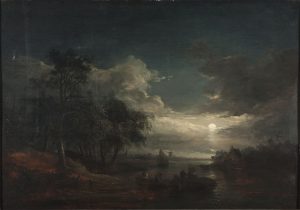
The samples were embedded in a clear substance called a thermoplastic, which becomes liquid when heated, but turns solid under room temperatures. One embedded sample was then ground down to create a cross-section, which shows that the blue was applied on a thin white ground.
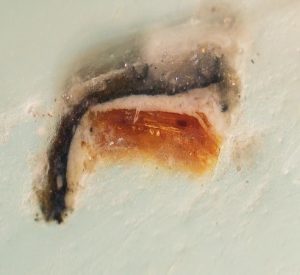
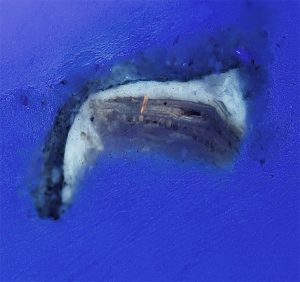
The other sample was chemically treated to isolate the blue pigment before being embedded and examined under a microscope. The shape, size, and refractive qualities of the pigment particles were studied, before testing their response to nitric acid. Many blue pigments that are known to look and behave differently could be excluded as candidates during this process.
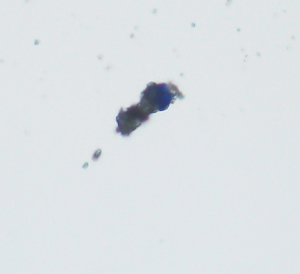
Finally, these results were compared with those from X-ray fluorescence (XRF) of the painting’s materials. In XRF analysis, elements are identified based on the different levels of radiation they reflect back when exposed to x-rays. Because XRF revealed the presence of iron (Fe), the blue pigment in this painting could be confirmed as Prussian blue: Fe4[Fe(CN)6]3 . Accidentally invented by a paint producer in Berlin in c. 1706, this synthetic pigment became widely available after 1730. We therefore know with certainty now that River Landscape by Moonlight could not have been done by a seventeenth-century artist like Van der Neer.
Forgery or misattribution?
Rejecting the attribution to Aert van der Neer presents two possibilities: first, that the work was deliberately forged to look like a genuine Van der Neer, or secondly, that it belongs to a legitimate, but as of yet unidentified artist active after 1730. Van der Neer’s works were commonly forged in the nineteenth century, as their romantic qualities were in high demand. One notable detail in the work could point to the involvement of a forger: an artist’s monogram in the lower right of the composition has been interpreted as Van der Neer’s signature in the past. Mostly illegible today, it could have been added to deliberately mimic Van der Neer’s well-known initials “AVDN.” However, this ambiguous signature could just as easily have belonged to an artist from a later period, whose name was eventually mistaken for that of Van der Neer. Works made after 1730 with a similar composition, style, and subject are currently being researched in an ongoing attempt to identify an artist whose body of work could include River Landscape by Moonlight. While this work remains unattributed at present, it is the museum’s responsibility to continue our assessment of its status and to educate audiences about our process of inquiry and its results.
The implications of the results from pigment analysis for the interpretation of River Landscape by Moonlight and its possible authorship were researched by curatorial intern Elise Kennedy ’21.
